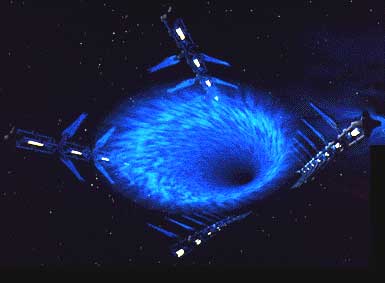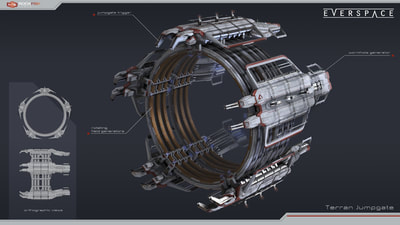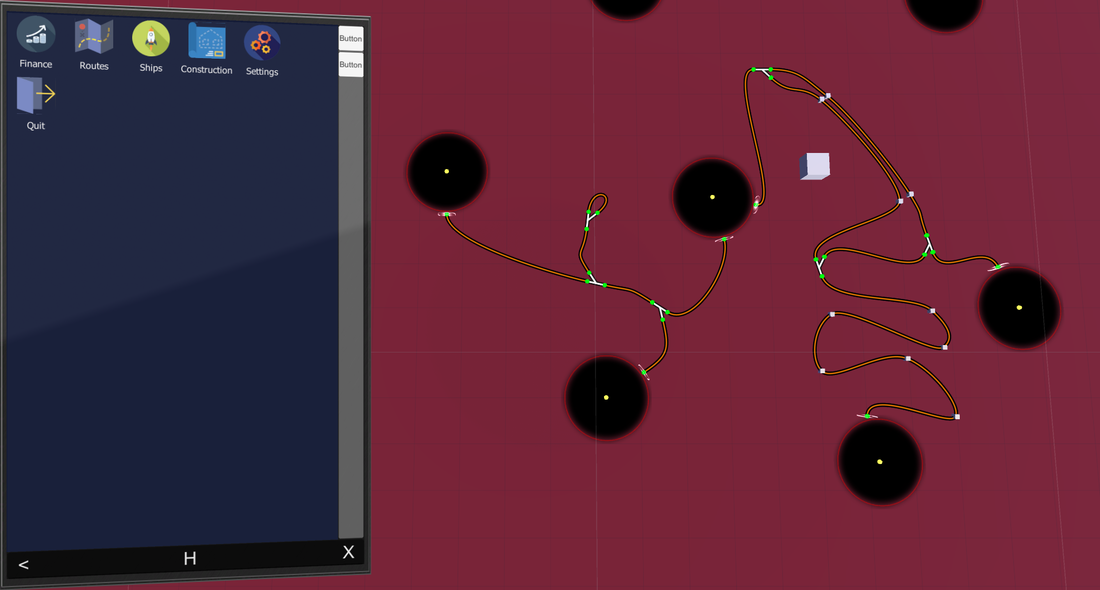So, we're building a space transportation game! The one-line concept is "Railroad Tycoon... in SPAAACE!"
The year is 4242. Fusion drive starships have allowed Humanity to colonize the solar system and spread throughout the stars on cryogenic sleeper ships. With the discovery of hyperspace technology, interstellar trade is budding. As a player, you are in charge of a transport company, with a fleet of ships carrying the needs and wants of a galaxy spanning civilization.
Freshly settled frontier outposts will need colonists, building materials, medicine and terraforming equipment. Rich, established core worlds want the latest fashions, red-and-chrome two-seater racing spaceships and other luxury goods. To get those made, zero-g manufacturing facilities need to be supplied with materials from extractors and mining facilities at gas giants and asteroid belts. Everyone knows the best optronics are made in the GlasTec Corporation crystal foundries in the Arcturus system, and Astrodyne Shipyards Ltd only wants the best for their new line of luxury yachts, so somebody had better deliver!
Of course, all this is just wild ideas in our heads at this point, so no guarantees any of it will actually end up in the game. But if you'll indulge me, I'd like to tell you about the first small steps we're taking.
The problem with space is that's it's really big (more on that in a later post!) and mostly empty, and that's not very interesting to look at. You can have pretty nebulas in the background and a nice atmospheric glow around your planets, but in the end, spaceships are cool but space is a pretty boring place.
To reduce travel time between stars, and make it interesting, interstellar travel will use hyperspace, a massively more compact alternate dimension parallel to normal space, which ships can enter through jump gates.
Our hyperspace will have a property called "hyperspace flux density". Traveling into greater flux density basically means going uphill: hyperspace will have a virtual landscape with "hills" and "valleys". The fastest route between two star systems won't be a straight line, but will have to snake around, using the flat valleys and avoiding high ridges. To add an additional challenge, hyperspace is also very "thin": hyperlanes will not be able to cross without interference. You'll have to carefully route and signal your hyperlane network so ships can move through efficiently.
While we're excited to start creating an elaborate simulation with a complex economy driven by supply and demand, we realize the potential of a game like this mainly hinges on a good user interface. It needs to be clear, and it needs to feel good to carefully thread your routes through the intricate hyperspace landscape. We want the player to sit back and look upon their finely woven tapestry of hyperlanes (or the horrible mess of hyperspaghetti if that's your thing), with each blip on the screen a ship zipping around brimming with precious cargo, and feel like the CEO of a transstellar corporation, taming the extradimensional void for the benefit of cilization (and massive profits).
So that's why I'm working on a prototype for the construction UI, so we can try out what works and what doesn't. Instead of a grid based construction system, I think a curve based system is a better fit for a space game. Players can construct jumpgates where ships transition into and out of hyperspace. In hyperspace, ships should travel in hyperspace lanes for fast, safe travel. Lanes can split and merge at hyperspace junctions. The path of a hyperspace lane can be adjusted by placing nav buoys the lane will pass through. Eventually, there may be depots and warehouses in hyperspace, so ships can transfer cargo and receive maintenance without having to exit and re-enter hyperspace.
It's not even in a state where I can show you a tech demo, so a screenshot will have to do.
The black circles are gravity wells, created by stars. You can't jump into hyperspace from inside a strong gravity field, so jump gates have to be placed far enough away from large mass concentrations (i.e., stars). Hyperspace is red, because it is red in Star Control 2, one of my favourite games of all time!
So far, I have basic mouse input handling (clicking, dragging, snapping, camera pan/zoom) and a very crude approximation of our "virtual tablet" UI concept. With this, we're working out the "flow" for various actions - should you click or drag to place a hyperspace lane? Do you have to push a button in the UI to start editing a lane, or should it be editable right away when you select it in the world? What if you accidentally drag something? There are a thousand decisions to be made, but I'm sure this is a worthwhile investment. We can also do some initial experiments with game mechanics: how big should stuff be? How much room do you need between gravity wells to allow interesting junction networks? What looks good and feels right?
I don't know either, but stay tuned and we'll keep you posted!
Hyperspaghettily yours,
Michiel
Michiel






 RSS Feed
RSS Feed